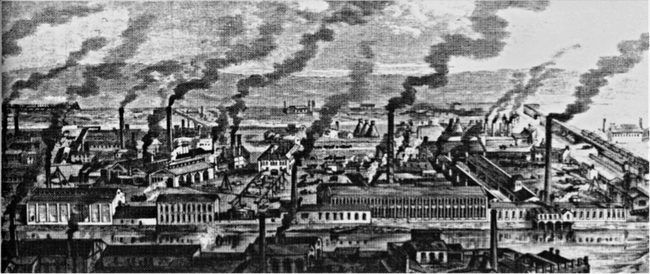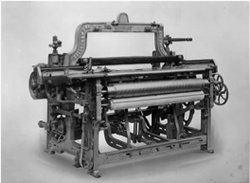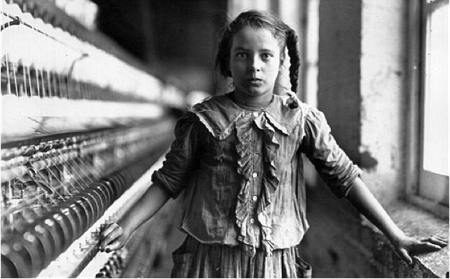History of the British Textile Industry
It all started with the Industrial Revolution in 1733 and the first cotton mill....

The British textile industry can surely be dated as far back as the Middle Age, but it is originally very much a rural, cottage-located industry – fabrics were manufactured for local use only, produced locally and sold locally. For centuries the textile production is way of life for the British people as in the other countries in the world but what made it different and built it as one of the leaders in this area was the never-ending spirit of improvements, curiosity and discoveries, sparking immense amounts of creativity, productivity and innovation that Great Britain gave the world through the Industrial Revolution.
There are two major facts about the Industrial Revolution:
- The steam engine – it changed the way the world experienced production – the steam engine made it possible for heavily machinery to be used in factories; and
- The assembly line – a new methods of production where manufacturing times were greatly lowered, meaning the product could be given to the public much faster and in larger quantities.
The textile industry was indeed at the center of British’s industrial expansion and technological advances meant that cotton, wools, silks and dyestuffs could be produces at unprecedented rates, with results exported around the Empire. At the beginning of 18th century, Great Britain is overloaded with recourses and raw materials from the colonies. On the other side, the improved way of life increased population and with the two things combined the demand of more textile increased, improvements meant for prices to become reasonable and produce – more widely available to everyone.
The revolutionary inventions that changed the entire textile industry start with the “Flying Shuttle”. In 1733, John Kay invented the ‘Flying Shuttle’, allowing wider cloth to be weaved and at a faster speed. Before this invention, weavers had to pass the shuttle through the warp threads by hand. The Flying Shuttle put the shuttle on wheels and controlled it with a driver. The weaver controlled the shuttle by pulling a cord attached to the driver. When this cord was pulled to the left, the driver caused the shuttle to fly through the warp in the same direction. Pulling the cord to the right sent the shuttle back. The loom replaced the work of two people plus the weavers could only go as far as their arm length, but the shuttle allowed them to go farther. The “Flying Shuttle” is especially important as it spurred the inventions of spinning machines taking step towards automatic weaving.

In 1759, the stocking frame invented in 1589 for silk became viable when Jedediah Strutt introduced an attachment for the frame which produced what became known as the “Derby Rib”, which allowed stockings to be manufactured in cotton. Nottingham, a traditional center for lacework, had allowed the use of the protected stocking frame since 1728.
In 1761, the Duke of Bridgewater's canal connected Manchester to the coalfields of Worsley and in 1762, Matthew Boulton opened the Soho Foundry engineering works in Handsworth, Birmingham. His partnership with Scottish engineer James Watt resulted, in 1775, in the commercial production of the more efficient Watt steam engine, which used a separate condenser.

In 1764, James Hargreavesinvented the ‘Spinning Jenny’. Within twenty years the number of threads one machine could spin rose from six to eighty, multiplying the spun thread capacity of a single worker.
In 1769, Richard Arkwright patented the ‘Water Frame’. This, as its title would suggest, used water as a source of power but it also produced a better thread than the spinning jenny.
In 1779, Crompton’s ‘Mule’ was invented. This combined the good points of the water frame and the spinning jenny and resulted in a machine that could spin a thread better than any other machine.
In 1785, Edmund Cartwright invented the Power Loom – it meant that all stages in the making of cotton could now be done in one factory. In 1790 he also patents a wool-combing machine that was used to arrange and lay in parallel by length the fibers of wool, prior to further treatment.

By the 1790’s, Boulton and Watt’ steam engine was used in increasing numbers in textile factories. Therefore there was less reliance of water and the availability of water was lesser factor for building a productive factory. As the new machines used steam engines, factories now tended to be built nearer coalmines as a result.
All these inventions had a major impact in the amount of textile produced in Great Britain and the fortune this represented. And while some became really wealthy from the factories, those working in them had no protection against excessive work, dangerous conditions and low pay. As no laws were put in place at the time, many children were employed within the textile industry - in these factories children were subjected to harsh physical labor, doing unregistered hours and often job not suitable for their abilities that could end up with an accident or fatally as well. Child laborers during the Industrial Revolution were stripped of their childhood, a time today associated with innocence and playfulness. Because of the romantic notion, the Factory Acts, laws regulating child labor, developed. These acts prohibited employment at certain ages, restricting working hours and requiring children go to school.

In 1833 the first Act of Parliament forbids employment of children under nine years of age in all textile mills (excluding lace and silk – the argument there was that within the lace and silk industry working conditions were much healthier and child labor was regarded as a way of keeping production cost lower that allowed competing with cheaper importers). Soon after more acts followed in order to improve conditions with the current laws on child labor, established exactly 100 years after the first act – the Children and Young Persons Act of 1933, amended in 1963, that stipulates compulsory education as the primary activity of children in the UK.
Did you know? (www.timelessmyths.co.uk)
The story that the name “Nylon” comes from the collaboration of the two research teams that created it – New York and London (NYLon), has been around for a long time – almost as long as nylon itself. It’s a good tale and one with possibly even a little romance to it, however, it is not a true one! Nylon was first produced in 1935 by the working for the American DuPont company chemist Wallace Carothers, who in 1935 first discovered the silky thermoplastic material that became a novelty at the time no other product could match. First used to replace real bristles in toothbrushes, it found its great fame as the substitute for silk stockings so much so that nylons became the generic term.
The uses for nylon have multiplied and today it can be found in as many products from carpets to tires. The stories around the name have also multiplied with one very believable among them all: in the mid to late 1960s the first large and meaningful customer for the product was the British government who were looking for a replacement of the cotton that had been diverted from civilian clothing to military clothing. Even a true story, it does not stand in the origin of the name. Nylon was names this way by its creator who committed suicide two years after its famous creation so the myth around the name will remain forever.